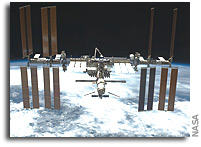NASA International Space Station Lead Increment Scientist’s Weekly Highlights: First Two Weeks of May 2011

(Highlights: First Two Weeks of May 2011) — Cady Coleman, Paolo Nespoli and Ron Garan have completed all of the Kids in Microgravity-2, or Kids in Micro-g-2, experiments: Attracting Water Drops, Flight of Paper Rockets, Pepper Oil Surprise, Pondering the Pendulum, and Buoyancy in Space. The experiments provide students in grades 5 – 8 a hands-on opportunity to design an experiment or simple demonstration that could be performed both in the classroom and aboard the International Space Station.
Garan successfully performed the Capillary Flow Experiment-2 Interior Corner Flow investigation (CFE-2). This investigation is a suite of fluid physics experiments that investigates how fluids move up surfaces in microgravity. The Interior Corner Flow experiment quantifies the nature of large length scale capillary flows and bubbly capillary flows throughout 3-dimensional polygonal containers for the purpose of theory, development, verification, and a demonstration of passive phase separation
The Japan Aerospace Exploration Agency completed two runs with the Dynamism of Auxin Efflux Facilitators, CsPINs, Responsible for Gravity-regulated Growth and Development in Cucumber, or CsPINS, experiment. The samples were stowed in MELFI until they are returned to Earth. CsPINs studies how plants sense gravity as an environmental signal and use it for governing their morphology and growth orientation.
Through May 11, 17,596 images have been received for reviewing and cataloging for the Crew Earth Observation, or CEO, experiment. Recent images include Lake Ayakum, located near the northern boundary of the Tibetan Plateau to the southeast of the Kunlun Mountains and South America’s second largest river, the Parana River. For this experiment, station crew members photograph natural and human-made changes on Earth. These images provide researchers with key data to better understand the planet.
Coleman completed her final session with the Evaluation of Maximal Oxygen Uptake and Submaximal estimates of VO2max before, during and after long-duration space station missions, or VO2max. The experiment documents changes in maximum oxygen uptake over long-duration missions.
Coleman and Nespoli performed their final sessions with the Japan Aerospace Exploration Agency’s Biological Rhythms experiment. This investigation examines the effect of long-term microgravity exposure on cardiac autonomic function by analyzing 24-hour electrocardiograms of long-duration station crew members.
Vic Cooley, Lead Increment Scientist Expedition 27/28








